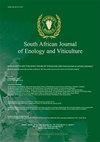葡萄(Vitis vinifera L. cv Albariño)成熟植株叶相关病毒-3对110R和196.17C砧木的影响
IF 1.1
4区 农林科学
Q4 FOOD SCIENCE & TECHNOLOGY
引用次数: 3
摘要
葡萄叶卷病(GLD)的有害影响主要记录在幼树上,很少有数据显示当葡萄藤达到成熟时被感染。本研究在一个20年葡萄球菌(Planococcus ficus)传播glrav3病毒的葡萄园Albariño中,研究了砧木对glrav3效果的影响。对嫁接在Richter 110和Castell 196.17上发育相似的植株进行了葡萄叶相关病毒的分析。特别地,我们选择了25株glav -3感染的葡萄树和25株无叶卷草和无症状的葡萄树,进行了为期三年的监测,以确定葡萄产量和必须成分。病毒侵染虽然影响了砧木上的植株,但对嫁接在110R上的植株的影响更大,平均累计产量损失高达33%,而196.17C上的植株损失为16%。110R(-2.1º白利度)条件下植株的甜瓜含糖量低于196.17C(-1.5º白利度)条件下植株的甜瓜含糖量。病毒的存在与初级氨基氮(PAN)和铵(NH4+)浓度的降低有关,对110R的影响最大(-35%)。由于110R是西班牙最常用的砧木,因此必须特别注意防止glav -3传播到新葡萄园110R上经认证的无病毒植株上。在Albariño等敏感品种中,特别是在粉蚧病毒活跃传播的地区,嫁接196.17C似乎可以将GLD在中长期内的影响降至最低。本文章由计算机程序翻译,如有差异,请以英文原文为准。
Influence of Grapevine Leafroll-associated Virus-3 in Mature Plants of Vitis vinifera L. cv Albariño on 110R and 196.17C Rootstocks
The detrimental effects of grapevine leafroll disease (GLD) have been documented mainly in young plantsand little data is available on infected grapevines when they reach maturity. This study examined theinfluence of the rootstock on the effect of GLRaV-3 in a 20-year-old Vitis vinifera cv Albariño vineyard inwhich the virus has been spread by Planococcus ficus. Plants grafted on Richter 110 or Castell 196.17 withsimilar development were analysed for grapevine leafroll-associated viruses. In particular, 25 GLRaV-3-infected and 25 leafroll-free and asymptomatic vines were selected and monitored during a period of threeyears to determine grape yield and must components. Although the virus infection affected plants on bothrootstocks, it caused a greater effect on plants grafted onto 110R, with average accumulated yield losses ofup to 33%, relative to losses of 16% for plants on 196.17C. The sugar content was lower in the must frominfected plants on 110R (-2.1ºBrix) than in the must from plants on 196.17C (-1.5ºBrix). The presence ofthe virus was associated with decreased concentrations of primary amino nitrogen (PAN) and ammonium(NH4+), with the greatest effect for 110R (-35%). As 110R is the most used rootstock in Spain, particularcare must be taken to prevent the transmission of GLRaV-3 to certified virus-free plants on 110R in newvineyards. In sensitive varieties such as Albariño, particularly in areas with an active spread of the virusby mealybugs, grafting on 196.17C seems to minimise the effect that GLD has in a medium to long term.
求助全文
通过发布文献求助,成功后即可免费获取论文全文。
去求助
来源期刊
CiteScore
2.50
自引率
7.70%
发文量
1
审稿时长
>36 weeks
期刊介绍:
The South African Journal of Enology and Viticulture (SAJEV) publishes full-length original Research Papers, Research Notes and Review Papers on all subjects related to enology and viticulture. The SAJEV does not accept articles published in, or submitted to, other journals.

 求助内容:
求助内容: 应助结果提醒方式:
应助结果提醒方式:


